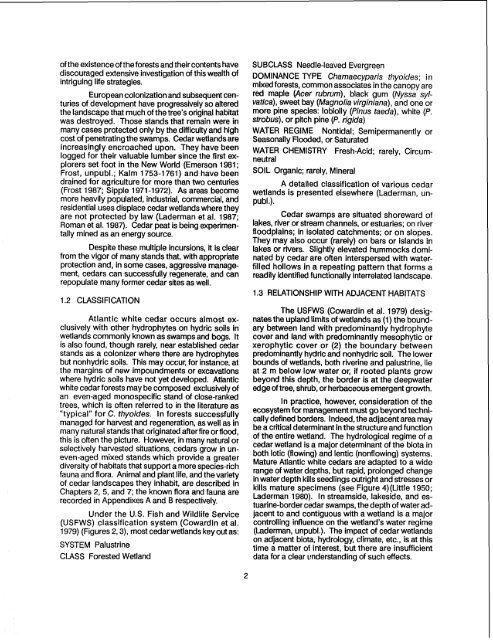The ecology of Atlantic white cedar wetlands - USGS National ...
The ecology of Atlantic white cedar wetlands - USGS National ...
The ecology of Atlantic white cedar wetlands - USGS National ...
Create successful ePaper yourself
Turn your PDF publications into a flip-book with our unique Google optimized e-Paper software.
<strong>of</strong> the existence <strong>of</strong> the forests and their contents havediscouraged extensive investigation <strong>of</strong> this wealth <strong>of</strong>intriguing life strategies.European colonization and subsequent centuries<strong>of</strong> development have progressively so alteredthe landscape that much <strong>of</strong> the tree's original habitatwas destroyed. Those stands that remain were inmany cases protected only by the difficulty and highcost <strong>of</strong> penetrating the swamps. Cedar <strong>wetlands</strong> areincreasingly encroached upon. <strong>The</strong>y have beenlogged for their valuable lumber since the first explorersset foot in the New World (Emerson 1981;Frost, unpubl.; Kalm 1753-1761) and have beendrained for agriculture for more than two centuries(Frost 1987; Sipple 1971 -1 972). As areas becomemore heavily populated, industrial, commercial, andresidential uses displace <strong>cedar</strong> <strong>wetlands</strong> where theyare not protected by law (Laderman et al. 1987;Roman et al. 1987). Cedar peat is being experimentallymined as an energy source.Despite these multiple incursions, it is clearfrom the vigor <strong>of</strong> many stands that, with appropriateprotection and, in some cases, aggressive management,<strong>cedar</strong>s can successfully regenerate, and canrepopulate many former <strong>cedar</strong> sites as well.1.2 CLASSIFICATION<strong>Atlantic</strong> <strong>white</strong> <strong>cedar</strong> occurs almost exclusivelywith other hydrophytes on hydric soils inwetlarlds commonly known as swamps and bogs. Itis also found, though rarely, near established <strong>cedar</strong>stands as a colonizer where there are hydrophytesbut nonhydric soils. This may occur, for instance, atthe margins <strong>of</strong> new impoundments or excavationswhere hydric soils have not yet developed. <strong>Atlantic</strong><strong>white</strong> <strong>cedar</strong> forests may be composed exclusively <strong>of</strong>an even-aged monospecific stand <strong>of</strong> close-rankedtrees, which is <strong>of</strong>ten referred to in the literature as"typical" for C. thyoides. In forests successfullymanaged for harvest and regeneration, as well as inmany natural stands that originated after fire or flood,this is <strong>of</strong>ten the picture. However, in many natural orselectively harvested situations, <strong>cedar</strong>s grow in uneven-agedmixed stands which provide a greaterdiversity <strong>of</strong> habitats that support a more species-richfauna and flora. Animal and plant life, and thevariety<strong>of</strong> <strong>cedar</strong> landscapes they inhabit, are described inChapters 2, 5, and 7; the known flora and fauna arerecorded in Appendixes A and B respectively.Under the U.S. Fish and Wildlife Service(USFWS) classification system (Cowardin et al.1979) (Figures 2,3), most <strong>cedar</strong> <strong>wetlands</strong> key out as:SYSTEM PalustrineCLASS Forested WetlandSUBCLASS Needle-leaved EvergreenDOMINANCE TYPE Chamaecyparis thyoides; inmixed forests, common associates in the canopy arered maple (Acer rubrum), black gum (Nyssa sylvatica),sweet bay (Magnolia virginiana), and one ormore pine species: loblolly (Pinus taeda), <strong>white</strong> (P.strobus), or pitch pine (P. rigida)WATER REGIME Nontidal; Semipermanently orSeasonally Flooded, or SaturatedWATER CHEMISTRY Fresh-Acid; rarely, CircumneutralSOIL Organic; rarely, MineralA detailed classification <strong>of</strong> various <strong>cedar</strong><strong>wetlands</strong> is presented elsewhere (Laderman, unpubl.).Cedar swamps are situated shoreward <strong>of</strong>lakes, river or stream channels, or estuaries; on riverfloodplains; in isolated catchments; or on slopes.<strong>The</strong>y may also occur (rarely) on bars or islands inlakes or rivers. Slightly elevated hummocks dominatedby <strong>cedar</strong> are <strong>of</strong>ten interspersed with waterfilledhollows in a repeating pattern that forms areadily identified functionally interrelated landscape.1.3 RELATIONSHIP WITH ADJACENT HABITATS<strong>The</strong> USFWS (Cowardin et al. 1979) designatesthe upland limits <strong>of</strong> <strong>wetlands</strong> as (1) the boundarybetween land with predominantly hydrophytecover and land with predominantly mesophytic orxerophytic cover or (2) the boundary betweenpredominantly hydric and nonhydric soil. <strong>The</strong> lowerbounds <strong>of</strong> <strong>wetlands</strong>, both riverine and palustrine, lieat 2 m below low water or, if rooted plants growbeyond this depth, the border is at the deepwateredge <strong>of</strong> tree, shrub, or herbaceous emergent growth.In practice, however, consideration <strong>of</strong> theecosystem for management must go beyond technicallydefined borders. Indeed, the adjacent area maybe a critical determinant in the structure and function<strong>of</strong> the entire wetland. <strong>The</strong> hydrological regime <strong>of</strong> a<strong>cedar</strong> wetland is a major determinant <strong>of</strong> the biota inboth lotic (flowing) and lentic (nonflowing) systems.Mature <strong>Atlantic</strong> <strong>white</strong> <strong>cedar</strong>s are adapted to a widerange <strong>of</strong> water depths, but rapid, prolonged changein water depth kills seedlings outright and stresses orkills mature specimens (see Figure 4)(Little 1950;Laderman 1980). In streamside, lakeside, and estuarine-border<strong>cedar</strong> swamps, the depth <strong>of</strong> water adjacentto and contiguous with a wetland is a majorcontrolling influence on the wetland's water regime(Laderman, unpubl.). <strong>The</strong> impact <strong>of</strong> <strong>cedar</strong> <strong>wetlands</strong>on adjacent biota, hydrology, climate, etc., is at thistime a matter <strong>of</strong> interest, but there are insufficientdata for a clear vnderstanding <strong>of</strong> such effects.

















